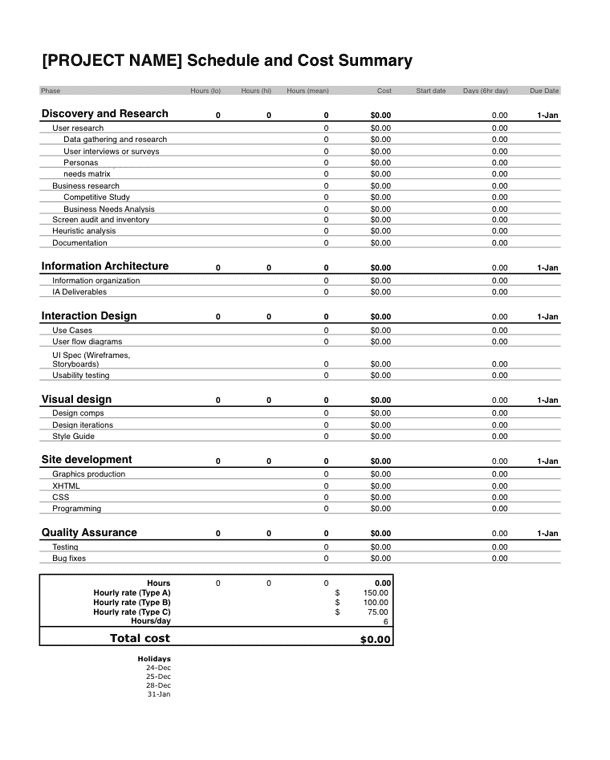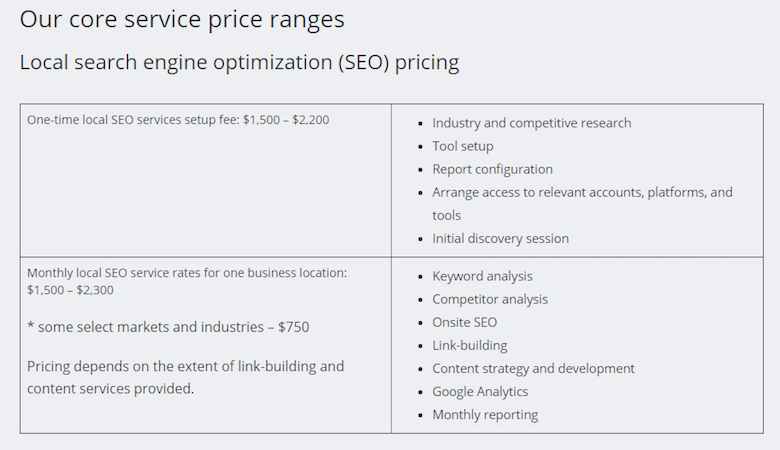- How to estimate project cost
- Resources and time approach
- Fixed price with a blended rate approach
- Budget development approach
- Estimating cost and time by project type
- Web design
- Content marketing
- Video production
- Social media ads
- SEO & SEM
- Event marketing
- Email marketing
- Google Ads & Facebook Ads
- Creating an ebook
- Free agency guide
Learning how to estimate project cost and time for your agency is essential for revenue growth and happy customers.
Quoting project time and cost can be challenging, especially when considering agency profit and delivering value to your clients. So, how do you establish a balance between the two?
If your agency struggles to estimate project cost and time, here are some points to consider, including project type and agency examples:
How to estimate project cost
Estimating costs before starting a project is vital for several reasons:
- You can understand client expectations, including their budget and business goals.
- The client can decide if they want to invest in your services at the price quoted.
- You can provide a breakdown of the project into tasks for team members to complete.
- You can define your approach and the resources you need to use.
When you estimate a project’s cost, it’s important to remember that this fee is a calculation, not a guarantee of the final price.
You can estimate project cost by breaking down the job into smaller tasks or milestones required to complete the project. Think about what these tasks might be and what resources are required to complete each task. For example:
- What team members need to be assigned to the project?
- What software is required?
- Is travel required?
Additionally, you should consider the time to complete each task and what it will take to earn a profit, not only break even.
Here are a few methods you can use to estimate time and cost…
1. Resources and time approach
This method is ideal for projects which are difficult to measure due to the extensive size, or where milestones may change along the way.
It factors time estimates and the number of resources used into account. The benefit of estimating project cost using this approach is that the client continues to pay, even if the project takes longer than expected.
But, the risk is that if the project is finished sooner than estimated, the agency will need to reimburse the client for any resources/time not used.
2. Fixed price with a blended rate approach
Estimate project cost with a fixed price and blended rate and you’ll charge clients one overall fee, rather than using specialist rates of individuals on your team.
This method usually incorporates the average cost of the whole team (combining individual rates and dividing them by the number of team members).
A fixed price works well when there is a straightforward project with fewer milestones. For example, the design of an event flyer or the creation of a specific post-click landing page.
However, it may be a risk for the agency, especially if you spend the budget before completion or if the project takes longer than expected to complete.
3. Budget development approach
A budget development approach takes into account varying options which can be added or dismissed during the development stage depending on the client’s budget for each part of the process. This method works well for large-scale creative projects which involve many aspects, such as video production.
Since video production can be an extensive project, using this approach allows both the agency and client to consider a baseline budget in addition to increases or decreases for creative elements (like multiple set locations, computer graphics, etc.).
Estimating cost and time by project type
Before a project cost estimate, the first thing you need to consider is the project type. You need to understand your client’s goals to establish the type of results they’re looking for.
For example, is the project a one-off activity, such as writing an individual blog article, or does it require continual work, such as developing a new content strategy?
Here are some of the different types of projects you may offer to understand how a project’s cost is calculated…
Web design
A web design project can range from a small-scale task like implementing new navigation to a complete full redesign. To estimate project cost, you can use one of the approaches listed above.
But, by considering the project type, you may wish to use a benchmark method — looking at previous projects completed and using similar projects to provide an estimated cost.
Vintage agency considers the type of website the client requires when estimating project costs.
The agency notes that different types of websites have varying costs and timeframes. For instance, a post-click landing page can be constructed quicker than a full website. They suggest using a tool like Konigi, a free calculator for estimating the cost and time of a web project:

Web design generally includes planning, solution design, front and back end development, content implementation, and testing. Each stage may be broken down into smaller tasks.
Vintage Agency suggests over-estimating the time estimate for a project, in addition to allowing for a margin of error.
Content marketing
Like web design, content tasks vary quite a bit. Extensive content marketing campaigns require time on overall strategy planning, keyword research, content ideas, writing, editing, posting content, promotion, and metric analysis.
To demonstrate, content marketing agency, Jawfish Digital, estimates project costs by tracking the time spent on each task. By tracking the time spent on each task for current clients, the agency can estimate time and cost for future projects more accurately:

Video production
Video production is often an extensive project. OC Creative estimates costs using a budget development approach.
The agency provides an initial project cost, letting clients know that the final price may be higher or lower depending on development. The overall cost will depend on the script and the video concept.
Using a budget development approach lets clients increase or decrease specific costs in production, while allowing the agency to use their creativity without worrying about budget constraints. For example, during client discussions, creative options can be added or eliminated depending on the scope of the project, leading to changes in cost.
Social media ads
Lyfe Marketing uses a fixed fee pricing model to estimate project cost and time for social media ads:

Using a fixed fee approach provides transparency for the client: they understand exactly what services they’re paying for with the same fee billed each month.
SEO/SEM
Dagmar Marketing estimates project cost and time by providing a custom fee for each individual client:

The agency recognizes that SEO/SEM can cover a wide range of tasks, including content development, conversion optimization, and SEO consulting. Providing a ballpark price range allows clients to determine if they have the budget for their services.
Dagmar Marketing prices their services using both cost and value-based pricing: initial set-up fees are fixed, while ongoing costs, such as tasks required to achieve campaign goals, are value-based.
Custom fee-based pricing allows the agency to consider the overall scope of the project and the needs of the client. For example, client 1 (a large local business) may only require an initial setup of SEO services, while client 2 (a new, small local business) may require setup in addition to SEM services on a monthly basis.
Event marketing
Similar to other project types mentioned in this article, event marketing can take months of planning, ranging from small, local events to national events. On The Avenue Marketing estimates time and cost by initially asking clients what their budget is:

Events can be costly. Not only is there marketing to consider, but also hosting fees, insurance, staffing, travel, materials, catering, and more to consider. That’s before any agency fees are calculated.
Event strategy, concept development, research, and event production are time-consuming and not every event will be the same.
Make Events also uses custom quoting for potential clients. However, the agency breaks their pricing down into four elements: creative and pre-planning, on-site event management, external event services, and handling fees:

Using a custom quote approach takes into account the size of the event, staffing, external elements, including travel and food, as well as insurance and sourcing. With this level of transparency, clients can better understand where their money is allocated.
Email marketing
Email marketing does not just encompass sending messages out. Rather, it can also include sending newsletters, creating email funnels, and nurturing leads. These tasks are often priced on a monthly basis unless the initial setup is the only task required.
Referencing Lyfe Marketing again, they use a fixed price model for social media ads, but also email marketing services, too:

The agency notes that their fee is based on the number of emails sent and managed campaigns, rather than a specific fee for everything. This approach enables Lyfe Marketing to tailor their pricing to the client’s needs; those requiring fewer emails and campaigns will pay a lower fee.
Google Ads or Facebook ads
Setting up Google or Facebook ads is usually a one-off task, unless the client requires ongoing ad management. For setup and management, we turn to Everest Agency offers both as the example here:

The agency uses an hourly fee method to estimate the cost of setting up advertisements. This approach enables them to bill the client for the overall time taken to set up the ads. Additionally, the agency likely uses in-house experts to set up ads. Therefore, they can estimate the cost using the hourly rate of the team member plus profit.
Creating an ebook
Developing an ebook is normally billed as an individual project, separate from other services. However, Big Ideas Machine uses a credit-based pricing approach to bill their clients:

By using a credit-based pricing model, the agency works on an outcome approach rather than time-based, so customers feel they’re paying for value rather than labor:

Estimate project cost and time more accurately
Estimating project costs and time are challenging but being upfront with your clients how your pricing works builds transparency and trust.
Your pricing structure will depend on the project type and the scale of the overall project. Mistakes in your estimations can be expensive, so calculate your projections with accuracy and be sure to account for hidden costs, such as extra employees or 3rd party resources that may be required.
Understand exactly what your client’s goals are because exceeding customer expectations to deliver a successful and profitable project is the key to agency growth.
Turn more of your ad clicks into conversions with the Instapage Advertising Conversion Cloud. With AdMap, 1:1 Personalization, built-in collaboration, pixel-perfect designs & more, no other solution can compare. Sign up for an Instapage Enterprise demo today.
